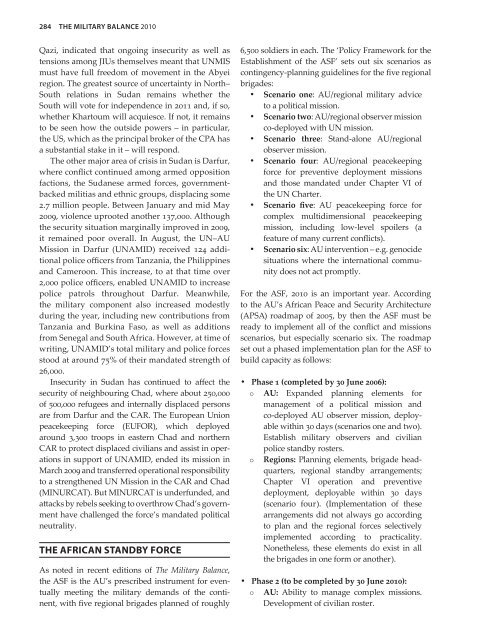Create successful ePaper yourself
Turn your PDF publications into a flip-book with our unique Google optimized e-Paper software.
284 The MiliTAry BAlAnce 2010<br />
Qazi, indicated that ongoing insecurity as well as<br />
tensions among JIUs themselves meant that UNMIS<br />
must have full freedom of movement in the Abyei<br />
region. The greatest source of uncertainty in North–<br />
South relations in Sudan remains whether the<br />
South will vote for independence in 2011 and, if so,<br />
whether Khartoum will acquiesce. If not, it remains<br />
to be seen how the outside powers – in particular,<br />
the US, which as the principal broker of the CPA has<br />
a substantial stake in it – will respond.<br />
The other major area of crisis in Sudan is Darfur,<br />
where conflict continued among armed opposition<br />
factions, the Sudanese armed forces, governmentbacked<br />
militias and ethnic groups, displacing some<br />
2.7 million people. Between January and mid May<br />
2009, violence uprooted another 137,000. Although<br />
the security situation marginally improved in 2009,<br />
it remained poor overall. In August, the UN–AU<br />
Mission in Darfur (UNAMID) received 124 additional<br />
police officers from Tanzania, the Philippines<br />
and Cameroon. This increase, to at that time over<br />
2,000 police officers, enabled UNAMID to increase<br />
police patrols throughout Darfur. Meanwhile,<br />
the military component also increased modestly<br />
during the year, including new contributions from<br />
Tanzania and Burkina Faso, as well as additions<br />
from Senegal and South Africa. However, at time of<br />
writing, UNAMID’s total military and police forces<br />
stood at around 75% of their mandated strength of<br />
26,000.<br />
Insecurity in Sudan has continued to affect the<br />
security of neighbouring Chad, where about 250,000<br />
of 500,000 refugees and internally displaced persons<br />
are from Darfur and the CAR. The European Union<br />
peacekeeping force (EUFOR), which deployed<br />
around 3,300 troops in eastern Chad and northern<br />
CAR to protect displaced civilians and assist in operations<br />
in support of UNAMID, ended its mission in<br />
March 2009 and transferred operational responsibility<br />
to a strengthened UN Mission in the CAR and Chad<br />
(MINURCAT). But MINURCAT is underfunded, and<br />
attacks by rebels seeking to overthrow Chad’s government<br />
have challenged the force’s mandated political<br />
neutrality.<br />
The african STandby force<br />
As noted in recent editions of The Military Balance,<br />
the ASF is the AU’s prescribed instrument for eventually<br />
meeting the military demands of the continent,<br />
with five regional brigades planned of roughly<br />
6,500 soldiers in each. The ‘Policy Framework for the<br />
Establishment of the ASF’ sets out six scenarios as<br />
contingency-planning guidelines for the five regional<br />
brigades:<br />
• Scenario one:<br />
AU/regional military advice<br />
to a political mission.<br />
• Scenario two:<br />
AU/regional observer mission<br />
co-deployed with UN mission.<br />
• Scenario three:<br />
Stand-alone AU/regional<br />
observer mission.<br />
• Scenario four:<br />
AU/regional peacekeeping<br />
force for preventive deployment missions<br />
and those mandated under Chapter VI of<br />
the UN Charter.<br />
• Scenario five:<br />
AU peacekeeping force for<br />
complex multidimensional peacekeeping<br />
mission, including low-level spoilers (a<br />
feature of many current conflicts).<br />
• Scenario six:<br />
AU intervention – e.g. genocide<br />
situations where the international community<br />
does not act promptly.<br />
For the ASF, 2010 is an important year. According<br />
to the AU’s African Peace and Security Architecture<br />
(APSA) roadmap of 2005, by then the ASF must be<br />
ready to implement all of the conflict and missions<br />
scenarios, but especially scenario six. The roadmap<br />
set out a phased implementation plan for the ASF to<br />
build capacity as follows:<br />
• Phase 1 (completed by 30 June 2006):<br />
{ AU: Expanded planning elements for<br />
{<br />
management of a political mission and<br />
co-deployed AU observer mission, deployable<br />
within 30 days (scenarios one and two).<br />
Establish military observers and civilian<br />
police standby rosters.<br />
Regions: Planning elements, brigade headquarters,<br />
regional standby arrangements;<br />
Chapter VI operation and preventive<br />
deployment, deployable within 30 days<br />
(scenario four). (Implementation of these<br />
arrangements did not always go according<br />
to plan and the regional forces selectively<br />
implemented according to practicality.<br />
Nonetheless, these elements do exist in all<br />
the brigades in one form or another).<br />
• Phase 2 (to be completed by 30 June 2010):<br />
{ AU: Ability to manage complex missions.<br />
Development of civilian roster.


